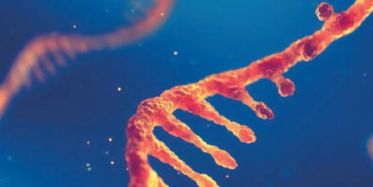Bin Tian, Ph.D.
-
Professor and Program Co-Leader, Genome Regulation and Cell Signaling Program, Ellen and Ronald Caplan Cancer Center
-
Director, Center for Systems & Computational Biology
Tian is a molecular systems biologist whose research is focused on understanding how gene expression is regulated at the RNA level. His lab was among the first to discover the widespread nature of alternative polyadenylation (APA) using bioinformatic and genomic approaches. They have also revealed multiple molecular mechanisms that regulate APA, cellular consequences of APA isoform regulation in diverse biological systems. His recent interests are APA regulation in cancers.
Tian received his B.S. degree in biochemistry from East China University of Science and Technology and his Ph.D. degree in molecular biology from Rutgers Biomedical and Health Sciences (formerly UMDNJ). He was a postdoctoral fellow in bioinformatics and genomics at Johnson & Johnson Pharmaceutical Research & Development in La Jolla, California. In 2003, he established his research group at Rutgers New Jersey Medical School, where he rose through the ranks and became a tenured professor in 2014. Tian joined The Wistar Institute in 2020.
The Tian Laboratory

The Tian Laboratory
Expression of the genetic code, from DNA to protein, can be regulated at different stages, much of which takes place after RNA is made. The Tian lab studies RNA biology using a variety of approaches including functional genomics, computational biology, and molecular and cellular biology. They have contributed important knowledge on the mechanisms and consequences of alternative polyadenylation (APA) in development and disease.

-
Research Assistant
Zezhong Wan
-
Postdoctoral Fellows
Shan Yu, Ph.D.
Qiang Zhang, Ph.D.
-
Multiple graduate student and postdoctoral positions are available in the Tian lab. Motivated candidates interested in experimental and/or computational research are encouraged to inquire about the positions by contacting Dr. Bin Tian, btian@wistar.org.
Research
Functional Genomics of Cleavage and Polyadenylation
Cleavage and polyadenylation (CPA) is responsible for the 3′ end maturation of almost all protein-coding and long non-coding RNAs in eukaryotic cells. The CPA site, commonly known as polyA site or PAS, also plays a key role in termination of transcription. Over 70-80% of human genes harbor multiple PASs, resulting in expression of mRNA isoforms with different 3′ termini, a phenomenon known as alternative cleavage and polyadenylation (APA). APA isoforms can differ in coding sequences and/or 3’ untranslated regions (3’UTRs). The Tian lab has been using a battery of sequencing tools, based on short-read and long-read sequencing technologies, to comprehensively map PASs across species and understand APA site evolution. They are also using single cell RNA sequencing methods to examine cell type specificity of APA isoform expression under physiological and pathology conditions. Moreover, using these technologies, the Tian lab is addressing how PAS choice is coupled with other events of mRNA biogenesis and processing, such as transcription, splicing and base modifications.
Regulation of Gene Expression Through Early Transcriptional Termination
While most PASs in human genes are located in the last exon, a sizable fraction (~20%) of genes display APA in regions upstream of the last exon. PAS usage upstream of the last exon, which has been named intronic polyadenylation, premature cleavage and polyadenylation or alternative terminal, leads to early transcriptional termination (ETT). While some ETT transcripts encode distinct proteins, the majority of them are unstable in the cell, making ETT a powerful mechanism to effectively inhibit gene expression. As such, regulation of ETT, often involving modulation of splicing and CPA activities as well as transcriptional elongation rate, can have substantial impacts on the gene expression program. The Tian lab is developing tools to regulate genes through ETT. In addition, they are studying how perturbation of ETT impacts neoantigen expression in cancer cells with the goal of enhancing cancer immunotherapies.
Spatial and Temporal Control of mRNA Metabolism Through Alternative 3’UTRs
The 3’UTRs of protein-coding transcripts play regulatory roles in mRNA metabolism, including mRNA decay, translation and subcellular localization. Sequence and structural motifs embedded in 3’UTRs contribute to 3’UTR functions through interactions with their cognate RNA binding proteins (RBPs) and microRNAs (miRNAs). The Tian lab recently reported widespread translation-independent endoplasmic reticulum association (TiERA) of mRNAs, in which 3’UTRs play an important role in modulating mRNA interactions with the endomembrane system in the cell. The Tian lab is studying how TiERA could impact cell signaling through localized mRNA translation. In addition, the Tian lab recently reported widespread transcript shortening in secretory cell differentiation. The phenomenon, named secretion-coupled APA (SCAP), was observed in multiple professional secretory cells. They are studying how SCAP perturbation in B cells can alter their differentiation into antibody-producing plasma cells, which are critical for humoral immunity. They are also pursuing novel therapeutics to modulate immune cells and cancer cells that display unique mRNA 3’UTR isoform biogenesis and metabolism.
Cleavage and Polyadenylation Inhibition (CPAi) in Cancer Therapies
Small molecule inhibitors of CPA (CPAi) have recently been found to be effective anti-cancer therapeutics. The Tian lab has revealed multiple mechanisms by which CPAi can impact the transcriptome in a cell, including APA isoform changes and transcriptional readthrough. In addition, they found that cancer cells with a high CPA activity and a high proliferation rate are particularly vulnerable to CPAi, due to replication-transcript conflicts. They are now developing novel, more potent CPAi compounds through medicinal chemistry and antisense oligonucleotides (ASOs) that are amenable to distinct therapeutic deliveries. In addition, they are studying cancer cell signatures that determine the effectiveness of CPAi in multiple cancer types.
Databases and Software

| PolyA_DB is a web-based database created by the Tian lab for comprehensive catalogs of pre-mRNA cleavage and polyadenylation (polyA) sites in multiple species. Learn More. |

| APAlyzer is a bioinformatics program developed by the Tian lab for analysis of APA isoform expression changes by using RNA-seq data. Learn More. |

| MAAPER is a bioinformatics program co-developed by the Tian lab and the Li lab at University of California, Riverside, for APA isoform expression analysis by using 3’ end-biased RNA-seq data from bulk samples or single cells. |
Tian Lab in the News
Selected Publications
Elevated pre-mRNA 3′ end processing activity in cancer cells renders vulnerability to inhibition of cleavage and polyadenylation.
Cui Y, Wang L, Ding Q, Shin J, Cassel J, Liu Q, Salvino JM, Tian B. Nat Commun. 2023;14(1):4480. doi: 10.1038/s41467-023-39793-8.
PMID: 37528120; PMCID: PMC10394034.
Neuronal Cells Display Distinct Stability Controls of Alternative Polyadenylation mRNA Isoforms, Long Non-Coding RNAs, and Mitochondrial RNAs.
Guvenek A, Shin J, De Filippis L, Zheng D, Wang W, Pang ZP, Tian B. Front Genet. 2022;13:840369. doi: 10.3389/fgene.2022.840369.
PMID: 35664307; PMCID: PMC9159357.
Widespread transcript shortening through alternative polyadenylation in secretory cell differentiation.
Cheng LC, Zheng D, Baljinnyam E, Sun F, Ogami K, Yeung PL, Hoque M, Lu CW, Manley JL, Tian B. Nat Commun. 2020;11(1):3182. doi: 10.1038/s41467-020-16959-2.
PMID: 32576858; PMCID: PMC7311474.


